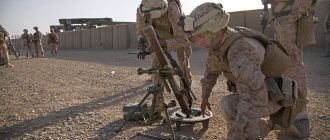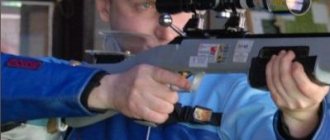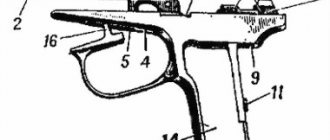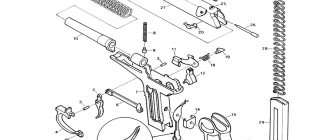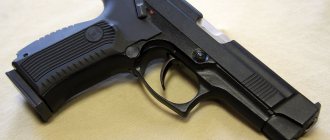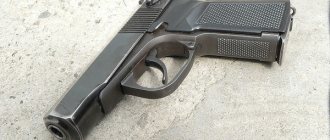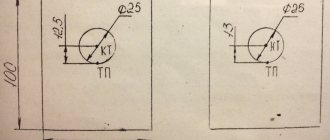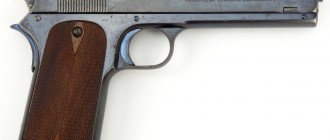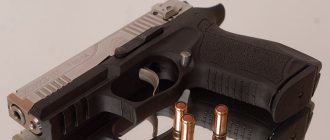General design of the pistol
Purpose and combat properties of PM.
AND RULES FOR HANDLING IT.
Having understood the general principles of the design and operation of pistols, you can move on to studying a specific type of weapon in service with the internal affairs bodies - the Makarov pistol.
After the Great Patriotic War, at the end of competitive testing of a number of domestic pistols, the N.F. Makarov (PM) pistol was adopted by the Soviet Army in 1951 (later it was adopted by the Ministry of Internal Affairs).
GENERAL INFORMATION ABOUT THE PISTOL
The 9-mm Makarov pistol (Fig. 9) is a personal weapon of attack and defense, designed to defeat the enemy at short distances. You can fire from it with your hand (if necessary, with both hands).
Fig.9. General view of PM.
Pistol fire is most effective at distances up to 50 m, that is, at these distances the natural spread of bullets does not exceed the size of the target (tall figure).
The destructive power of a bullet remains up to 350 m, that is, at this distance, a bullet hitting the vital organs of a person who is not protected by special means can lead to death.
Pistol fire is carried out only in single shots.
The pistol's combat rate of fire is up to 30 rounds per minute, taking into account its automatic reloading, magazine change, target selection, transfer of fire from one target to another, etc.
For pistol shooting, 9 mm pistol cartridges are used. The initial speed of the bullet is 315 m/sec.
The cartridges are fed into the chamber during firing from a replaceable magazine with a capacity of 8 rounds.
Pistol weight: with magazine without cartridges 730 g;
with loaded magazine 810 g.
Pistol dimensions: length 161 mm; height 126.75 mm.
Barrel length 93 mm. It has 4 grooves.
The weight of the cartridge is 10 g, the bullet - 6.1 g.
Thus, based on the listed combat properties, we can conclude that the PM fully meets the requirements of the conditions for performing service and combat missions by police officers: small in size, comfortable to wear, and has sufficient lethality.
The PM is a self-loading weapon, since it is reloaded during firing automatically, using the energy of the powder gases. The operation of the automatic pistol is based on the principle of using the recoil of a free bolt, that is, the bolt has no clutch with the barrel. The movement of the bolt back and forth is carried out by sliding its longitudinal protrusions along the corresponding grooves on the pistol frame. The bolt has a large mass and is held in the forward position by the force of the return spring, due to which reliable locking of the barrel bore is achieved when fired.
The pistol is equipped with a hammer-type self-cocking trigger mechanism (open trigger), therefore, if there is a cartridge in the chamber, you can quickly open fire (by turning off the safety) by directly pressing the trigger without first cocking the hammer, that is, self-cocking.
For safety when handling it, the pistol has a mechanical safety device located in the rear of the bolt. It is switched by a flag on the left side of the shutter. When the safety is turned on (horizontal position of the safety flag), it locks the trigger and bolt (they do not move back), blocks the trigger (the trigger does not reach the firing pin) and raises the sear. In addition, the trigger is automatically set to the safety cock. This ensures that there will be no accidental discharge when the trigger hits hard objects and is dropped with the pistol’s safety switch off.
The trigger guard protects the trigger from accidental pressing.
The PM consists of the following main parts and mechanisms (Fig. 10):
— frame with barrel and trigger guard;
- bolt with firing pin, ejector and fuse;
— return spring;
- handle with screw;
- shutter stop;
- shop;
- trigger mechanism (trigger, sear with spring, trigger rod with cocking lever, mainspring, mainspring slide, trigger).
Fig. 10. Main parts and mechanisms of the PM:
1 — frame with barrel and trigger guard; 2 - bolt with firing pin, ejector
and fuse; 3 — return spring; 4 — parts of the trigger mechanism; 5 — handle with screw; 6 - shutter stop; 7 - store.
Each pistol comes with accessories: spare magazine, wiper, holster, pistol strap.
Pistols, machine guns, machine guns. Purpose, combat properties, general structure
Combat and linear data of the 9-mm Makarov pistol (PM)
| Item no. | Data name | PM |
| 1 | Weight of the pistol with magazine without cartridges, g | 730 |
| 2 | Weight of the pistol with a magazine loaded with eight rounds, g | 810 |
| 3 | Gun length, mm | 161 |
| 4 | Gun height, mm | 126,75 |
| 5 | Barrel length, mm | 93 |
| 6 | Barrel caliber, mm | 9 |
| 7 | Number of rifling | 4 |
| 8 | Magazine capacity, cartridges | 8 |
| 9 | Cartridge weight, g | 10 |
| 10 | Bullet weight, g | 6,1 |
| 11 | Chuck length, mm | 25 |
| 12 | Combat rate of fire, rounds per minute | 30 |
| 13 | Initial bullet speed, m/s | 315 |
| 14 | Most effective fire, m | up to 50 |
| 15 | Range to which the lethal effect of a bullet is maintained, m | up to 350 |
Rice. 2. General design of the PM pistol
1 — frame with barrel and trigger guard; 2 - bolt with firing pin, ejector and fuse; 3 — return spring; 4 — parts of the trigger mechanism; 5 — cheeks of the handle with a screw; 6 - shutter stop; 7 – store
Rice. 3. Accessory to the PM pistol a - holster; 1 - body; 2 - cover; 3 — pocket for a spare magazine; 4 - front wear loop; 5 - rear wear loop; 6 — fastener; 7 — loops for wiping; 8 — internal auxiliary strap. b - spare magazine. c - rubbing; 1 - blade; 2 — wiping slot; 3 – protrusion. g — pistol strap; 1 - belt; 2 — carabiner; 3 - loop
Kalashnikov AK74 assault rifle
Rice. 4. General view of the AK74 assault rifle The 5.45 mm Kalashnikov assault rifle is an individual weapon. They are designed to destroy manpower and destroy enemy fire weapons. To defeat an enemy in hand-to-hand combat, a bayonet-knife is attached to the machine gun. For shooting and observation in natural night light conditions, the AK74N and AKS74N assault rifles are equipped with a universal night rifle sight (NSPU).
* Additional letters in the abbreviated name of the machine gun (machine gun) indicate: “N” - with a night sight; "C" - with a folding butt.
| Item no. | Data name | AK74 |
| 1 | Sighting range, m | 1000 |
| 2 | Direct shot range: according to chest figure, m according to a running figure, m | 440 625 |
| 3 | Rate of fire, rounds per minute | ~600 |
| 4 | Combat rate of fire, rounds per minute: when firing single shots when firing in bursts | 40 100 |
| 5 | Most effective fire against ground targets, m | up to 500 |
| 6 | Most effective fire on airplanes, helicopters and paratroopers, m | up to 500 |
| 7 | Concentrated fire on ground group targets, m | up to 1000 |
| 8 | Initial bullet speed, m/sec | 900 |
| 9 | Range to which the lethal effect of a bullet is maintained, m | 1350 |
| 10 | Maximum bullet flight range, m | 3150 |
| 11 | Machine weight, kg (without bayonet): with an empty plastic magazine with equipped plastic magazine | 3,3 3,6 |
| 12 | Magazine capacity, cartridges | 30 |
| 13 | Weight of plastic magazine, kg | 0,23 |
| 14 | Weight of bayonet-knife, kg: with scabbard without scabbard | 0,49 0,32 |
| 15 | Caliber, mm | 5,45 |
| 16 | Machine length, mm: machine gun with attached bayonet-knife machine gun without bayonet | 1089 940 |
| 17 | Barrel length, mm | 415 |
| 18 | Length of the rifled part of the barrel, mm | 372 |
| 19 | Number of grooves, pcs. | 4 |
| 20 | Rifling stroke length, mm | 200 |
| 21 | Sighting line length, mm | 379 |
| 22 | Front sight thickness, mm | 2 |
| 23 | Cartridge weight, g | 10,2 |
| 24 | Weight of a bullet with a steel core, g | 3,4 |
| 25 | Powder charge weight, g | 1,45 |
Rice. 5. General structure of the AK74 1 assault rifle - barrel with receiver, with trigger mechanism, sighting device, butt and pistol grip; 2 — muzzle brake-compensator; 3 — receiver cover; 4 — bolt frame with gas piston; 5 - shutter; 6 — return mechanism; 7 — gas tube with receiver lining; 8 — fore-end; 9 - store; 10 — bayonet; 11 — ramrod; 12 — pencil case accessories.
Rice. 6. Accessory to the AK74 assault rifle 1 – ramrod; 2 – rubbing; 3 – brush; 4 – screwdriver; 5 – drift; 6 – pencil case; 7 – cover; 8 – oiler; 9 – clip; 10 – adapter.
Kalashnikov RPK74 light machine gun
Rice. 7. General view of the RPK74 machine gun The 5.45-mm Kalashnikov light machine gun is a rifle squad weapon. They are designed to destroy manpower and destroy enemy fire weapons. For shooting and observation in natural night light conditions, the RPK74N and RPKS74.N machine guns are equipped with a universal night rifle sight (NSPU).
* Additional letters in the abbreviated name of the machine gun (machine gun) indicate: “N” - with a night sight; "C" - with a folding butt.
Rice. 8. General structure of the RPKK74 1 machine gun - barrel with receiver, with trigger mechanism, sighting device, butt, pistol grip and bipod; 3 — receiver cover; 4 — bolt frame with gas piston; 5 - shutter; 6 — return mechanism; 7 — gas tube with receiver lining; 8 — fore-end; 9 - store; 10 — bayonet; 11 — ramrod; 12 — pencil case accessories; 13 – flame arrester.
Rice. 9. Accessory to the RPK74 machine gun 1 – ramrod; 2 – rubbing; 3 – brush; 4 – screwdriver; 5 – drift; 6 – pencil case; 7 – cover; 8 – oiler; 9 – clip; 10 – adapter.
Kalashnikov tank machine gun (PKT) The 7.62-mm Kalashnikov machine gun (PKT - tank) is a powerful automatic weapon and is designed to destroy enemy personnel and firepower.
Rice. 10. General view of the PKT machine gun
Rice. 11. General structure of the PKT machine gun 1-barrel; 2 receiver with cover, receiver base and butt; 3 – bolt frame with extractor and gas piston, 4 – bolt; 5 – return spring; 6 — guide rod; 7 – gas piston tube; 8 – electric release; 9 – trigger mechanism
Rice.
12. Accessory to the PKT 2 tank machine gun - ramrod; 3 - wipe, 4 - brush: 5 - screwdriver; 6 — drift; 7 — pencil case with a lid; 8 - extractor; 9 – oiler; 10 — frame for firing blank cartridges; 11 — bushing for firing blank cartridges Tags: fire preparation
How to make a gun from paper and cardboard
All models, from a simple pistol folded using the origami technique, to a complex revolver that shoots bullets, can be easily and simply made from ordinary cardboard and paper.
Dense materials should be used for work. This is especially important when creating shooting models. High-quality materials are more wear-resistant and will last longer.
Step-by-step assembly of a cardboard gun that shoots
A cardboard gun that shoots rubber bands can be made in the current style of the Minecraft game.
To work you will need:
- A4 paper;
- Printer;
- thick cardboard;
- ruler, pencil;
- glue gun with silicone rod;
- PVA glue;
- black acrylic paint.
Assembly order:
1. Print the template using a color or regular printer.
2. Cut 4 identical blanks.
3. Cut out the middle part of 2 parts, leaving room for the trigger.
4. Glue the parts with silicone glue, as shown in the diagram.
5. Cover the layout with paper tape or pieces of paper to cover the side sections.
6. Paint the gun with black acrylic paint and let dry.
7. Using PVA glue, glue the printed gun templates to the end sides. If the image is black and white, color it with markers or felt-tip pens.
8. Make the trigger in the form of a small rectangle.
9. Make a small cutout on the top side for the elastic to cling to.
Varieties of crafts with assembly diagrams
By spending just half an hour, you can make a serious man's craft. It could be a paper Colt, a cardboard Deagle, or a simple shooting design made from paper tubes. Master classes contain instructions with detailed descriptions, photographs and diagrams.
Origami of simple and light weapons
The art of folding paper shapes without glue originated in Ancient China and is called Origami.
For children's origami-style creativity, you should use paper that is not too hard, as it is difficult to bend. It is better to take medium density material.
In just 15 minutes, in this style you can assemble a Nagan and surprise a bored child, at the same time causing a storm of emotions and admiration in him.
To work you need to take 2 office sheets of paper.
Progress:
1. Fold the sheet crosswise and straighten it again. Fold the bottom of the sheet to the center line and cut off the bottom quarter along the resulting fold. Set aside the resulting rectangle.
2. Bend the square in half and straighten it. Fold the top and bottom edges of the sheet, aligning with the center.
3. Repeat the addition again. Fold the resulting part in half.
4. Fold the second sheet in half lengthwise and repeat the sequence of folds as with the first sheet.
5. Fold the long strip in half.
6. Step back 2.5 cm from the fold and fold the strip as in the picture.
7. Wrap a short strip around the longer part of the gun.
8. Fold the free edges under the paper braid.
9. From the trimmings of the first sheet, form 3 rectangles.
10. Roll 2 tubes from large rectangles and insert them into the base of the gun.
11. Roll the trigger from a small rectangle.
12. If you cut a small notch on the back of the gun, you can make a model that will shoot rubber bands.
The simplest origami gun can be made in 5 minutes. How to make a paper gun that shoots is shown in the following photographs and videos.
Paper tube shooting gun
From simple sheets rolled into tubes, you can make a gun that shoots bullets in a matter of minutes. How to make such a model is described in the next master class.
To work you will need:
- Sheets of office paper.
- Scissors.
- Stationery erasers.
- Scotch.
Assembly instructions:
1. Make 4 tubes from paper sheets. For strength, twist each tube from 2 sheets. You should get 2 narrow and 2 wide tubes.
2. Cut the parts as shown in the picture below.
3. Use tape to secure the structure.
4. Glue a strip of folded paper along the bottom edge of the gun, securing it in the back under the second long tube, and in front near the end of the gun barrel.
5. Make a trigger mechanism by bending the folded part and inserting it into 2 and 3 tubes from above.
6. Make another narrow tube, smaller than the length of the gun barrel. Bend one end and secure 3 rubber bands in it using tape.
7. Thread the resulting part into the upper tube, turning the bent end downwards.
8. Make bullets from paper.
9. To fire, pull out the piston, fix it with the curved end and pull the trigger.
The following video shows the assembly sequence in detail:
Applications for children
A child can make such a gun with his own hands. The craft can be simple, in the form of cardboard covered with colored templates. To make a bright craft, just print out a picture, cut out 2 or 3 pieces of cardboard using the same pattern and glue them together.
Glue the printed templates on both sides of the resulting blank and paint them in the color you like.
You can create a 3D model, which consists of several layers of glued cardboard and follows the outline of a real pistol.
To make this type of weapon, you need to print out a diagram and transfer the base and three-dimensional parts onto cardboard. Glue the structure with PVA glue. If desired, the surface of the product can be painted.
Pistol PM-T
The PM-T pistol is a self-defense weapon, which is made on the basis of the combat PM (Makarov pistol) by installing a smooth barrel with a small partition pin located immediately behind the chamber. In addition, there are weakening grooves instead of the original rifled barrel. The PM-T barrel is generally similar in design to the barrel of the Grand Power T12 pistol. PM-T is the fruit of the joint work of ZID OJSC and PKP AKBS LLC, which developed this type of weapon taking into account the forensic requirements that are currently in force on the territory of the Russian Federation. The main goal pursued by the designers when creating this self-defense weapon was the maximum preservation of “historical value” by minimizing interventions and alterations in the original design. The appearance of the PM-T traumatic pistol on the Russian market became a real sensation. For the first time, Russian citizens had the opportunity to obtain personal ownership of a pistol that shoots rubber bullets, made from a Makarov combat pistol by replacing the standard rifled barrel with a barrel with a smooth bore, which has a pin behind the chamber and weakening grooves, eliminating the possibility of using bullets from hard materials. In fact, the PM-T differs from the Makarov pistol only in the cartridge used - 9mm PA, which has a rubber bullet instead of the combat 9x18. Thanks to this, the PM-T pistol is the most authentic version of the PM, which uses a traumatic cartridge.
An important circumstance that arouses great interest in this weapon is the fact that PM-Ts have not only the properties of a self-defense weapon, but also a collection value. They are made from combat PMs produced from the early 50s to the late 80s of the last century. The vast majority of PM-T pistols are conversions of Makarov pistols produced in the 60-70s. The surface treatment of the bolt casing and frame has been preserved; there is no new coating or grinding. In addition, the original numbers were retained. It must be taken into account that PM produced in Soviet times is distinguished by the use of high quality steel, surface treatment and manufacturing. This especially applies to weapons produced from the 50s to the 70s. Unfortunately, modern versions of Makarov pistols and pistols produced in the 90s cannot even be closely compared in quality to weapons manufactured in the USSR.
As a result of this approach, an outwardly undamaged PM was produced, with a wide “anti-glare” bar, “bearded”, with original bluing and numbered parts. Apart from small external differences, such as laser-applied markings on the right side of the frame, stamped on the left side of the bolt-casing in front of the gun number “T” or “1”, as well as a smaller bore diameter, people who purchase the PM-T get almost a pistol identical to a combat PM that fires rubber bullets. The value of the PM-T became visible immediately after the first announcement appeared, which the manufacturer posted on the Internet, on its own website and on a popular forum about weapons. Modest information about the release of such a pistol caused a stir among gun lovers. Especially among those who are interested in the historical value of weapons.
In addition, interest in this pistol was fueled by a legislative ban on the manufacture of signal, pneumatic and gas weapons with the possibility of using rubber bullets from the main parts of military weapons. This amendment to the Weapons Law, along with other changes, came into force on July 1, 2011, so AKBS and OJSC ZiD had to produce the maximum number of PM-T pistols before the “rainy day.” The PM-T pistol, in fact, has become a low-volume weapon. The result of this was that from the moment the PM-T appeared in stores towards the end of May, buyers, during the initial sales period, lined up in the morning and “snatched up” pistols, regardless of the condition of the coating, year of manufacture and price. Those who managed to purchase one of the PM-Ts, of which about 5 thousand were produced in total, did not go wrong. Today the cost of these pistols is only increasing. If in June the price in gun stores was about 16-18 thousand rubles, now PM-Ts are sold “from hand” for 50 thousand rubles.
The PM-T automatic operates using blowback recoil. The return spring was left original, from combat examples. The springs, which were badly worn, were replaced with new ones. The resource of these return springs is very long, due to the lower recoil impulse of the 9mm PA traumatic cartridge compared to live cartridges. However, many owners are faced with a problem caused by a strong return spring. There were delays in firing due to the cartridge not being filled enough. This is very important when using low-power traumatic cartridges. The solution to this problem was the installation of return springs from MP-654K air pistols.
Unfortunately, some of the pistols from the first batches had poor quality barrels, so there were delays due to the cartridge sticking during feeding. But the AKBS company very quickly influenced the manufacturer and pretty soon the PM-T pistols were freed from these shortcomings, as for weapons released from the beginning of June. However, the bevel of the chamber and the bore of pistols of a later release still require polishing to improve the reliability of chambering cartridges and shooting accuracy. Double action trigger mechanism, hammer type, with automatic safety cocking. Descent with warning. When firing in single action mode with a pre-cocked hammer, the trigger force is 2 kilograms, when firing in self-cocking mode it is about 4.5 kilograms.
The trigger stroke of Makarov pistols, manufactured in the Soviet Union since 1955, is smooth. In addition, it is short enough for the trigger mechanism of a combat pistol. All parts of the trigger mechanisms of pistols produced before the 1980s are made by milling. The bolt stop lever is located on the left side of the frame. For more reliable extraction of cartridges, we can recommend that owners of PM-T pistols, which have a slide stop with a wide “tooth” of the reflector, replace this part with an earlier one - with a narrow long reflector. Although not necessary, in many pistols the original "blown" slide stop, which has a wide "tooth", works well. The PM-T fuse is located on the left side of the bolt. If it is turned on, the firing pin is blocked and the hammer is safely released from the cocking position. The safety lock in the on position blocks the bolt-casing and sear, while the trigger does not touch the firing pin. To turn off the safety, the lever is moved to the lower position, that is, with one natural movement of the thumb of the hand holding the weapon.
Sighting devices - a fixed front sight, made as part of the bolt-casing, and a rear sight, fixed in a dovetail-type groove. Lateral adjustments are possible. The single-stack magazine holds eight rounds. The magazine is secured in the magazine well using a spring latch at the bottom of the handle. This option is a more reliable method than fixing it using a side latch at the base of the trigger guard. The disadvantages include the lower speed of replacing a magazine while reloading a weapon. The PM-T kit included only one magazine. Subsequently, the owners bought additional magazines, mainly corresponding to the production period of the purchased pistol. The most common are magazines of the 54-85 model with stamping on the bottom left side. These magazines correspond to most PM-T pistols and cost about 500 rubles. And in general, PM-T is very valuable due to the availability of spare parts. Original parts that were made in Soviet times are very easy to find, and they are relatively inexpensive.
In addition to high quality, significant service life, as well as historical value, the PM-T is a fairly effective and reliable self-defense weapon. The positive and negative qualities of the PM-T are almost the same as those of the prototype. The disadvantages of the pistol include the long trigger stroke, as well as its rather large force, like that of the Makarov combat pistol, which affects the shooting accuracy. A narrow handle with a small angle of inclination takes some getting used to, especially if the owner has previously used a more ergonomic weapon. Shooting accuracy is also negatively affected by small-sized, actually rudimentary, sighting devices with a small slot in the rear sight and a low and narrow front sight. Such sighting devices are not suitable for maneuverable firing at short distances. But if you want to achieve greater accuracy and accurate shooting during high-speed shooting, you can very quickly, you get used to the PM-T, and its shortcomings are easily compensated by developing skills in handling a pistol.
Among the most important advantages of the pistol, which was created by Nikolai Fedorovich Makarov, is reliability of operation in the most difficult operating conditions. This quality has been proven both in tests and during operation in the active army, and in harsh combat conditions in various countries around the world. The PM combines the best qualities of short-barreled self-defense weapons. This gun is very reliable, compact, safe, durable, easy to maintain and handle. All properties of the Makarov combat pistol are also relevant for the PM-T. This traumatic pistol does not seem like a plastic toy or a cheap light-alloy craft. This is a reliable and durable pistol that you can rely on in an emergency. And here, in theory, we need a much more powerful cartridge than the currently produced 9mm PA - traumatic cartridges, since even a new-made PM-T pistol barrel can withstand much greater loads. However, this issue is beyond the competence of those who purchase a pistol to protect the health and life of themselves and their loved ones.
According to many, the PM-T pistol is today one of the best self-defense pistols on the Russian market, made on the basis of a combat model with a steel frame. Having studied the disadvantages and advantages of various traumatic revolvers and pistols, we can conclude that it is the PM-T that meets most of the requirements for this type of weapon, namely: reliability of operation regardless of operating conditions; ease of maintenance and use; invisibility during concealed carry and compactness; sufficiently high shooting accuracy at long distances for self-defense; the base is exclusively a military weapon; frame material – steel. Plus, PM-T has historical value.
Here’s what one user writes about this pistol: “My acquaintance with this pistol happened in mid-June. Like most PM-T pistols, the selected example had signs of use and time in the form of a worn coating and the presence of small scratches on the handle. But this circumstance did not upset, but gave the weapon charisma and ambiance. “A well-worn”, this PM was manufactured in 1972 with excellent quality using excellent weapons-grade steel. The first impression of this pistol is that it is a real, normal weapon, a proven and reliable PM! And even the fact that I was holding a PM-T in my hands, which uses rubber bullets, did not add a fly in the ointment. The weapon is quite simple, but at the same time elegant in its own way, with the charisma of a high-quality weapon from the times of the Soviet Union - a great country that no longer exists. A wide anti-glare bar, beautiful black bluing, a large “beard” in the front part of the bolt-casing... The safety, trigger and ejector have the original red bluing, which is typical for Soviet-made Makarov pistols. Even a very narrow handle does not seem so inconvenient when you are holding in your hands not a cheap plastic craft, but a high-quality and reliable Soviet pistol made of high-quality weapon steel.
On the same day, the pistol was tested using powerful cartridges. The PM-T showed excellent accuracy at a range of seven meters. The weapon's automatic system worked perfectly. However, later, due to the dispersion of cartridge power and in order to ensure reliable extraction when using low-power ammunition, it was necessary to replace the original return spring with a slightly weaker one. The sound of the shot is biting and very loud, and the recoil is very reminiscent of shooting from Makarov combat pistols. For shooting, the most powerful available 9mm PA cartridges were used - AKBS Magnum for Inna. The PM-T pistol in combination with these cartridges is a very effective weapon for self-defense. The shooting results give no reason to doubt this. In general, I want to use the gun again and again. Of course, today on the self-defense weapons market you can buy more powerful pistols with double-row capacious magazines, for example Groza-02 with a v4 barrel of 9mm PA caliber without pins and “teeth” in the barrel or Grand Power T-12 with 10×28T. But the quality of workmanship, steel and surface treatment of the PM-T pistol produced during the Soviet Union, in my opinion, is superior to the Thunderstorm. In addition, the version with a v4 barrel is usually sold at an inflated price, given the lack of historical value. The T-12 is a truly successful pistol, but its very large dimensions, in particular its width, as a rule, do not allow this pistol to be used for concealed carry.”
The PM-T pistol is purchased not only by ordinary citizens for the purpose of self-defense, but also by collectors, lovers of weapons and Makarov pistols. However, today, among the samples of pistols that fire rubber bullets and those made from combat pistols from the times of the Soviet Union available for purchase by ordinary Russian citizens, there are several quite interesting models. This is Leader, Leader-M and MP-81, from TT pistols. APS-M and MP-355, made from Stechkin automatic pistols. But... All TT-based weapons have a lot of changes, which significantly reduces their historical value. All of these pistols require certain modifications to function reliably and be somewhat consistent with the historical original. A similar situation is observed with the APS-M, which, among other things, due to the design of the barrel, which tears rubber balls, is simply a working model of the APS, but not a weapon for self-defense. MP-355 does not have some of the shortcomings of the APS-M, but at the same time there are no original numbers and stamps, which reduces its historical value to a minimum.
Against this background, the PM-T looks like the best choice. It is valued both as a collector's item and as a reliable weapon for self-defense. It is quite pleasant to shoot and pleasant to hold. The PM-T is very convenient for concealed carry, not only in an armpit or belt holster, but also in a belt bag. The gun is not burdensome and quite light. There is a very large selection of cartridges for it, which can be purchased at any gun store anywhere in the country. For most, PM-T is, first of all, part of the history of a great state. Until citizens of the Russian Federation are given the right to carry and own combat rifled short-barreled weapons - revolvers and pistols that fire live cartridges with a solid bullet, and Glocks, Makarovs, Colts, Walters and Smith-Wessons do not appear on store shelves, PM-T pistols will be one of the best examples of small arms. Advantages:
— high strength; — reliability; — ease of maintenance; - familiar to use; — compactness; — availability of spare parts.
Flaws:
- not an ergonomic handle; — large force and travel of the trigger; — rudimentary sighting devices; — low quality of barrel manufacturing and adaptation to 9mm PA cartridges
Main characteristics:
caliber – 9mm R.A. (9x22); length: weapons - 161.5 millimeters; trunk - 93.5 millimeters; height – 126.5 millimeters; width – 30.5 millimeters; weight – 730 grams (without cartridges); Magazine capacity - 8 rounds.
Based on materials from the website armory-online.ru
The Makarov pistol
After the end of World War II in the USSR, the question arose of replacing the TT pistol and revolver with a more modern model of short-barreled weapons. Based on the experience of the Great Patriotic War, very stringent requirements were imposed on the samples submitted to the competition. The pistol had to have a caliber of 7.62 mm or 9 mm, smaller dimensions and weight compared to the TT, and be reliable and safe to use. F.V. Tokarev, S.G. Simonov, N.F. Makarov, I.I. Rakov and other designers took part in the competition. As a result, in 1951, the 9-mm pistol of the Makarov system (PM) was adopted. Nikolai Fedorovich himself described his success this way: “How can you explain my success in creating a pistol? First of all, the colossal work that I put into the business. Suffice it to say that at that time I worked every day, practically without days off, from 8 a.m. until two or three in the morning, as a result of which I modified and shot two or even three times more samples than my rivals , which certainly made it possible to perfect reliability and survivability. After all the “ordeals” the PM remained trouble-free. It fired twice as many shots as expected. After careful comparison of data, the State Commission recognized this sample as the winner of the competition. This day was a holiday for me, and holidays do not happen often in the life of a designer.” For the creation of the pistol, Makarov was awarded the Stalin Prize, 3rd degree. Subsequently, Nikolai Fedorovich continued to work in Tula, developing aircraft guns. In 1974 he was awarded the title of Hero of Socialist Labor.
Nikolai Fedorovich Makarov. (wikipedia.org)
The Makarov pistol is slightly smaller in size and weight compared to the Tokarev pistol due to the use of a shorter cartridge. The 9 mm caliber increased the stopping power of the bullet. PM allows only single fire. Food is supplied from a detachable single-stack magazine with a capacity of 8 rounds. PM is reliable in operation and relatively easy to maintain. Unlike the TT, where there is no safety, the Makarov pistol is equipped with a flag-type safety. The weapon is very technologically advanced and easy to manufacture. The production of the Makarov pistol was launched in Izhevsk. In addition to the USSR, the Makarov pistol was in service with a number of Warsaw Pact countries. Analogues of PM were also produced in China and Korea. There is no public data yet regarding the number of Makarov pistols produced in the USSR.
Modernized Makarov pistol. (huntsmanblog.ru)
In literature and the Internet you can often find the figure of 5 million units, but where did it come from? There are two options here - either the author, by citing such a figure, is revealing a state secret, or he simply takes the figure based on his own mood and inner beliefs. The figure of 5 million units is clearly overestimated - it turns out that more PMs were produced than Tokarev pistols (TT-33) and the 1895 model revolver combined. And this was in conditions when there were no major wars on the scale of the First World War, Civil War or the Great Patriotic War, which were associated with a large loss of weapons. A similar situation has developed with the production quantity of the Kalashnikov assault rifle, where, according to the “approximate” estimates of the authors, very different figures appear: 50, 80 and 100 million units.
When the Makarov pistol was developed in the late 1940s and early 1950s, the need to defeat an enemy protected by body armor was irrelevant. And at the end of the 20th century, with the development of personal protective equipment, it was very problematic to hit an enemy protected by body armor with a pistol with a low bullet speed. Therefore, to eliminate this drawback, the PMM was created - a modernized Makarov pistol. Unlike its predecessor, it had an increased magazine capacity of not 8, but 12 high-power cartridges. The design of the pistol itself was also strengthened. However, during the difficult times of the first half of the 1990s, the PMM did not find its place in the army weapons system and was transferred to the Ministry of Internal Affairs. But it soon became clear that, due to the great external similarity, cartridges with pressed gunpowder for PMMs began to be mistakenly used in PMs, as a result of which, after two or three shots, the bolt flies into the shooter’s forehead. Therefore, in order to avoid mistakes and injuries, it was decided to refuse PMM here too.
Makarov pistol, diagram. (fotki.yandex.ru)
At the beginning of the 21st century, the service life of the Makarov pistol is coming to an end, and the weapon requires replacement, but it is very difficult to say what the next mass model of the pistol for the army will be. There are at least two questions: for whom in the army will this pistol be intended and what characteristics should it have? It is clear that a mass-produced army model should be relatively cheap and technologically advanced to produce. What else? In conditions where large-scale wars are not ongoing, a significant part of the service of such weapons will be within the military unit. Another complex and controversial question is what is the role of a pistol in modern combat, based on the experience of local conflicts. In recent decades, a number of pistols have been adopted by the Russian army, but so far none of them have become a replacement for the Makarov pistol.
Main options[edit]
Combat[edit]
- MP
(sic!) produced in
1949
- pre-production release. The first 30 pieces were manufactured at the Tula Arms Factory (one of them can be seen in the TsMVS exhibition; another is known as a gift to J.V. Stalin from Tula gunsmiths), another 5000 - at the Izhevsk Mechanical Plant No. 622. - PM
produced
1953-54
. — a small feature has been made: the automatic reset of the slide stop when a full magazine is attached has been removed, because the feature could lead to an accidental shot. - PM
produced
after 1954
- the shape of the frame has been changed for greater ease of shooting with winter gloves. It is still produced today with minor changes. In the army it is gradually being replaced by the Yarygin pistol, in the FSO - by foreign-made pistols, in the Ministry of Internal Affairs it will remain the main pistol until the end of time for many, many years. - PMM
- modernized version of 1994.
Designed for firing a reinforced cartridge in the same dimensions as the old one, therefore it is equipped with a massive bolt and Ivshin grooves in the chamber (the principle of operation is similar to the Revelli grooves, but has a different geometry). It is also almost always equipped with a double-row magazine with a capacity of 12 rounds (on paper there is also a version with a standard single-row magazine for 8 rounds - PMM-8, but, apparently, production did not go beyond several prototypes). Attention!
The main defining feature of the PMM is the bolt, and not the two-row magazine.
Calling any macaroid with a wide handle but a regular bolt “PMM” is stupid. Attention-2!
Production of PMM has been discontinued. Yes exactly. Good night, sweet prince! And the ordinary PM is alive and well. Dear MTA, if you are describing a realistic setting with a time period after the second half of the 2000s and your policeman/military gets a brand new PMM instead of the old Makar, don’t write! Think about it! Such a pistol cannot be new, at most it can be left over from the old days.
The PMM can fire the old cartridge: when firing it, the Ivshin grooves do not slow down the rollback; The PM, on the other hand, does not withstand firing with a reinforced cartridge.
- Prototype from 1947. Note the lack of a swivel bracket.
- Pistol 1949 with MP markings (Makarova Pistol)
- PM 1953
- PM produced after 1954 (different frame shape)
- PMM. Pay attention to the shape of the shutter
Official, civil and commercial[edit]
- Izh-71
is a 9×17 caliber service pistol. A security guard might have one. There is an option with a double-stack magazine with a capacity of 10 rounds (according to the Weapons Law, 12 are not allowed). - Izh-70
(
IJ-70
) - export commercial versions. Available in 9×18 and 9×17 calibers, with single or double stack magazines, fixed and adjustable rear sights, standard blued finish or decorative finish. Capitalism, however! - Baikal-442
is an export modification developed specifically for the US market.
It comes standard with a double-stack, fully adjustable magazine, a side magazine release button and a reshaped trigger guard. After the United States introduced restrictions on the import of Izhmekh pistols, they forgot about it for a long time - but recently they remembered and certified it on the Russian market as the “ Baikal-442
” sports pistol (now in Cyrillic). - Izh-79
,
MP-79
,
MP-80
,
PM-T
,
P-M17T
- gas and traumatic pistols, one of the most popular on the Russian civilian weapons market. - MP-654K
is an air pistol produced by the Izhevsk Mechanical Plant. In cinema, he regularly passes for a combat PM from afar.
Partially based on PM design[edit]
- PB
(silent pistol) - a pistol with an integrated silencer designed by A. A. Deryagin. Contrary to popular misconception, the PB differs significantly from the PM in design and in no way can be called a “PM with a silencer.” However, the magazine and most of the trigger parts are unified with Makarov's. - PSS
“Vul” is much more similar to the PM structurally (and much less externally). Silent pistol chambered for a special closed-type cartridge SP-4.
Foreign production[edit]
- Under Soviet license, the PM was produced in the GDR ( Pistole M
), China (
Type 59
), Vietnam (
K59
) and Bulgaria (
Makarov Pistol
(sic!) and the modernized
Arsenal R-M01
).
Non-existent[edit]
- PM with silencer. It has never been produced by anyone (with the exception of artisanal criminal alterations). The prevalence in cinema can be somehow justified by the unavailability of authentic PB and the presence of pneumatic replicas with a false muffler. Common in other forms of art is banal hackwork and problems with weapons. It is impossible to screw the muffler onto the PM, if only because there is nothing to screw on - the cut of the barrel does not protrude even a millimeter from the bolt.
Firing delays and ways to eliminate them
43. A pistol, when handled correctly, carefully maintained and preserved, is a reliable and trouble-free weapon.
However, during prolonged operation due to wear of parts and mechanisms, and more often due to careless handling and inattentive maintenance, delays in shooting may occur.
44. To prevent delays when firing a pistol and ensure trouble-free operation of the pistol, it is necessary:
- properly prepare the pistol for shooting;
— inspect, clean and lubricate the gun in a timely manner and in compliance with all rules; Take special care to ensure that the rubbing parts of the gun are clean and lubricated;
- repair the pistol in a timely manner;
— before shooting, inspect the cartridges;
Do not use faulty, rusty or dirty cartridges for shooting;
- during shooting and when moving, protect the pistol from contamination and impacts;
- if the pistol was in severe frost for a long time before firing, then before loading it, vigorously retract the bolt by hand several times and release it, and after each retraction and release of the bolt, release the trigger by pressing the tail of the trigger.
45. If there is a delay during shooting, it must be eliminated by reloading the pistol. If recharging does not eliminate the delay, then it is necessary to find out the cause of the delay and eliminate it as indicated below.
| Delays | Reason for the delay | Ways to eliminate delays |
| 1. Misfire. The bolt is in the extreme forward position | 1. The cartridge primer is faulty 2. Thickening of the lubricant, contamination of the channel under the firing pin 3. The handle screw is not fully screwed in (in pistols without a mainspring bolt) 4) The output of the striker or nick on the striker is small | 1. Reload the pistol and continue shooting 2. Inspect and clean the gun 3. Screw in the handle screw until it stops 4. Send the gun to the workshop |
| 2. Failure to cover the cartridge with the bolt. The shutter stopped before reaching the extreme forward position; the trigger cannot be pulled | 1. Contamination of the chamber, frame grooves and bolt cup 2. Difficult movement of the ejector due to contamination of the ejector spring or pressure | 1. Push the bolt forward with a push of your hand and continue shooting 2. Inspect and clean the gun |
| 3. Failure to feed or advance the cartridge from the magazine into the chamber. The bolt is in the forward position, but there is no cartridge in the chamber; the bolt stopped in the middle position along with the cartridge, without sending it into the chamber. | 1. Contamination of the magazine and moving parts of the gun 2. Curvature of the upper edges of the magazine body | 1. Reload the pistol and continue firing. Clean the gun and magazine 2. Replace the faulty magazine |
| 4. Seizing (pinching) of the cartridge case by the bolt. The cartridge case was not thrown out through the window in the bolt and became wedged between the bolt and the breech end of the barrel | 1. Contamination of the moving parts of the gun 2. Malfunction of the ejector, its spring or reflector | 1. Throw away the stuck cartridge case and continue shooting 2. If the ejector with a spring or reflector is faulty, send the gun to a workshop |
| 5. Automatic shooting | 1. Thickening of the lubricant or contamination of parts of the trigger mechanism 2. Wear of the hammer cocking or sear nose. 3. Weakening or breaking of the sear spring 4. Touching the shelf of the fuse ledge of the sear tooth | 1. Inspect and clean the gun 2. Send the gun to the workshop Same |
